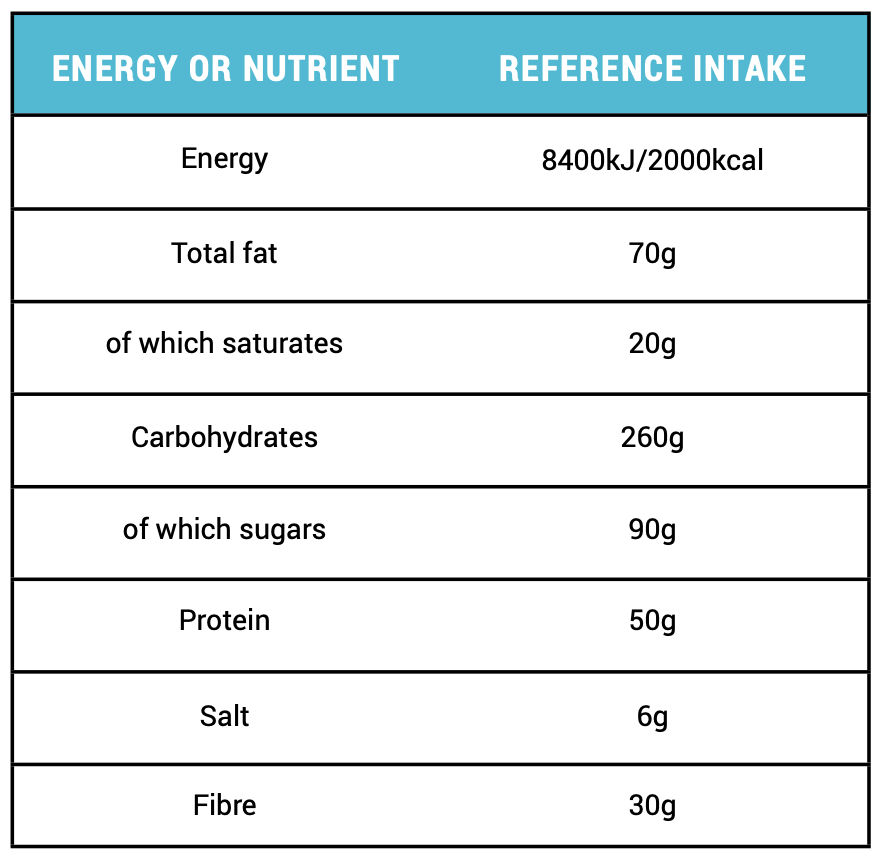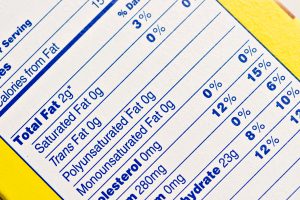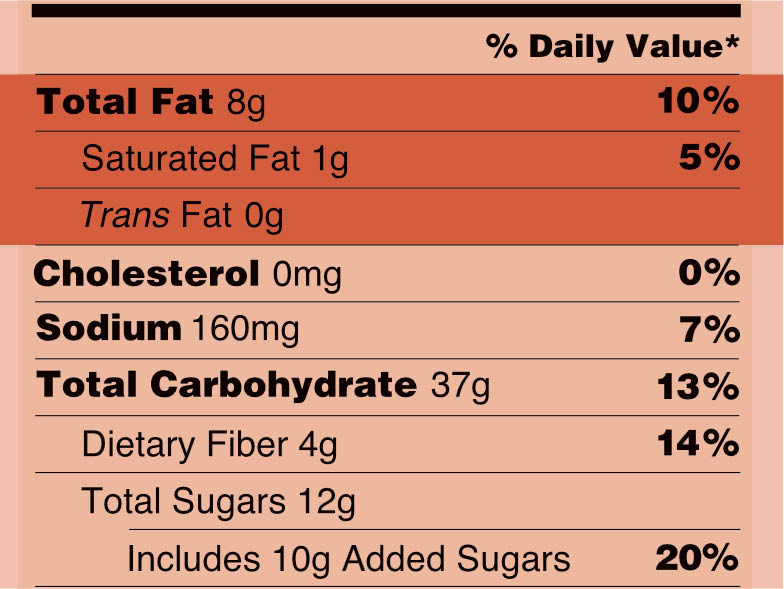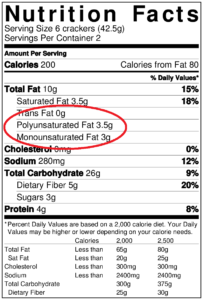40 understanding fat on nutrition labels
PDF How to Understand and Use the Nutrition Facts Label 5. Understanding the Footnote on the Bottom of the Nutrition Facts Label (#5 on sample label) Note the * used after the heading "%Daily Value" on the Nutrition Facts label. It refers to the Footnote in the lower part of the nutrition label, which tells you "%DVs are based on a 2,000 calorie diet". This statement must be on all food labels. But the Understanding the Nutrition Facts Label - Know Diabetes by Heart Fats Although fat can also contribute to changes in your blood sugar, they have less influence than carbs. However, it is important to reduce amount of saturated and trans fats as a part of a balanced diet. Replacing foods that are high in saturated fat with healthier options can lower blood cholesterol levels and improve lipid profiles. Sodium
Food labels 101: Understanding the nutrition facts panel The guideline is that five percent or less is low in a nutrient and 20 percent or more is high. For example, if a nutrition facts panel says that the %DV for calcium is 20 percent and iron is four percent, then you know that the food item is high in calcium but low in iron. Note: There is no %DV for sugars, trans fat and protein.
Understanding fat on nutrition labels
Understanding Nutritional Labels - Beaumont Health Here are the parts of most food labels: Calories (total calories and calories from fat) - This part of the label tells you how many calories each serving has and how many of those calories come from fat. Total Fat - Total fat is the number of fat grams per serving. There are different types of fat. Some are good for you and some aren't. Reading Food Labels | ADA - American Diabetes Association Put food labels to work. The Nutrition Facts labels on foods are really the key to making the best choices. We'll cover the basics so that these labels make shopping easier for you. You've heard it all. From carb-free to low-carb, to whole and empty carbs, it's hard to know what it all means. Blood sugar highs and lows aren't always ... Understanding Food Labels | The Nutrition Source | Harvard T.H. Chan ... For example, a bag of potato chips may advertise that it has 40% less fat and is cholesterol-free, suggesting it is a "healthy" food, when in reality even a "healthier" potato chip is still a high-calorie ultra-processed food offering little nutrition. Some terms are not yet regulated by the FDA such as " natural " or "multigrain."
Understanding fat on nutrition labels. Low Carb Guide to Understanding Nutrition Labels - Virta Health According to labeling laws in the U.S., if a food contains less than 0.5g of trans fat per serving, the label can say 0g, so be sure to read the list of ingredients. You can spot trans fats by the words "hydrogenated" or "partially hydrogenated" with oils. Sugar-free or Low-carb: Don't be fooled by clever packaging and slick marketing. Understanding Nutrition Labels and Information Here is a guide to understanding what those nutritional claims mean: Low Calorie: Less than 40 calories per serving. Calorie Free: Less than 5 calories per serving. Fat-Free: Less than 0.5 grams of fat per serving. Sugar-Free: Less than 0.5 grams of sugar per serving. High Fiber: 5 grams or more of fiber per serving. How to read food labels: MedlinePlus Medical Encyclopedia Nutrition Facts: How to Read Nutrition Labels - Greatist Here are some to look for: Calorie-free: Less than 5 calories per serving. Low calorie: 40 calories or less per serving. Reduced calorie/fat: At least 25 percent less calories/fat than the ...
Understanding Nutrition Facts on Food Labels - WebMD Serving Size: An Important Part of Food Labels. At the top of the Nutrition Facts section, you'll see the serving size (such as 1/2 cup, five crackers, or 10 chips) and servings per container (such as two, four, six). The food label then lists the number of calories, grams of fat, grams of saturated and trans fat, etc., per serving. How to Understand and Use the Nutrition Facts Label | FDA Nutrients to get less of: Saturated Fat, Sodium, and Added Sugars. Saturated fat, sodium, and added sugars are nutrients listed on the label that may be associated with adverse health effects - and... How to understand food labels - Eat For Health The Nutrition Information Panel on a food label offers the simplest and easiest way to choose foods with less saturated fat, salt (sodium), added sugars and kilojoules, and more fibre. It can also be used to decide how large one serve of a food group choice or discretionary food would be and whether it's worth the kilojoules. Food Labels: Fat & Cholesterol | Home & Garden Information Center The Nutrition Facts label shows you how much fat is in a product, even if the fat is hidden as an ingredient. The serving size and the nutrients listed on this label are consistent, which makes it easy to compare similar products without any calculations. % Daily Values (% DVs) are listed in a column on the "Nutrition Facts" label.
Understanding Food Nutrition Labels | American Heart Association When the Nutrition Facts label says a food contains "0 g" of trans fat, but includes "partially hydrogenated oil" in the ingredient list, it means the food contains some trans fat, but less than 0.5 grams per serving. So, if you eat more than one serving, you could end up eating too much trans fat. Get the Facts! Steps to Reading and Understanding Nutrition Facts Labels Compare the amount of fat, saturated fat, cholesterol and sodium to the total amount recommended (see the % Daily Value). Try to minimize trans fat in your diet. Eating too much of these may increase your risk of developing chronic diseases. Eating too much saturated fat and/or trans fat, for example, may increase your risk of heart disease. Understanding and Using the Nutrition Facts Label fat-free or 1% low-fat dairy products, eggs, lean meats packaged foods, snacks, and condiments. Limit baked and poultry, seafood, soy products, nuts, and seeds. Tips for understanding the Nutrition Facts Labels Limit fats in your diet to 5%-20% DV for individual food items Aim to have 100% of the % DV of fiber, vitamins, and minerals in your diet—checking labels for the % DV in individual foods can help you achieve that goal Read the label before you eat the food The bottom line The following chart of Percent Daily Values is based on a 2,000-calorie diet.
Fat Content on Food Labels - Reading Between the Lines The Mayo Foundation continued, "Still, you may be able to tell if a product contains trans fat, even if it's not directly listed on the food label. Look for the words ' hydrogenated ' or 'partially hydrogenated' in the list of ingredients. These terms indicate that the product contains trans fat.
Reading Food Labels (for Parents) - Nemours KidsHealth Fats are an important source of energy — they contain twice as much energy per gram as carbohydrates or protein. Fats provide insulation and cushioning for the skin, bones, and internal organs. Fat also carries and helps store certain vitamins (A, D, E, and K). Saturated Fat and Trans Fat
Interpreting Total Fat and Types of Fat on Food Labels - Nina Cherie ... Now, at the end of the day, since all high-fat foods tend to drive up calorie counts, it's typically recommended that you limit your intake of total fat to 25-35% of your daily calories. Of this amount, saturated fats and trans fats should comprise less than 7-10% and no more than 1%, respectively.
Understanding Ingredients on Food Labels - American Heart Association Understanding Ingredients on Food Labels. Food labels are an important source of information about calories and the nutritional value of the foods you eat, a crucial tool in building a heart-healthy diet. The Nutrition Facts information is always displayed in the same orderly fashion and helps you understand how much of certain nutrients that ...
Understanding Nutrition Fact Labels | Penn Highlands Healthcare Next to most of the nutrients, you will see % Daily Value (or %DV). These percentages tell you how much one serving of food contributes to the total amount of that nutrient you should consume each day, based on a 2,000-calorie daily diet. For instance, if the %DV listed next to sodium is 28%, one serving of that food gives you 28% of the total ...

Knowledge, Attitudes and Understanding of Low-fat Nutrition Labels/Claims among University Students
Reading and understanding the Nutrition Facts Label for health It is important to direct your attention to the top nutrient section that includes fat, saturated fat, trans fat, cholesterol, sodium and added sugars. These nutrients should be limited. Aim for eating products that have 0 percent trans fat and less than 5 percent saturated fats. Generally 5 percent or less is low and 20 percent or more is high.
Food Labels | CDC If you eat the whole thing, you are eating 8 times the amount of calories, carbs, fat, etc., shown on the label. Total Carbohydrate shows you types of carbs in the food, including sugar and fiber. Choose foods with more fiber, vitamins, and minerals. Choose foods with lower calories, saturated fat, sodium, and added sugars. Avoid trans fat.
Understanding Food Nutrition Labels - American Heart Association When the Nutrition Facts label says a food contains "0 g" of trans fat, but includes "partially hydrogenated oil" in the ingredient list, it means the food contains some trans fat, but less than 0.5 grams per serving. So, if you eat more than one serving, you could end up eating too much trans fat.
PDF Interactive Nutrition Facts Label - Understanding and Using the ... Understanding and Using the Nutrition Facts Label 1 Calories 240 Amount per serving Serving size 1 1/2 cup (208g) 4 servings per container Saturated Fat 1.5g the food. % Daily Value* Y Total Fat 4g Trans Fat 0g Cholesterol 5mg Sodium 430mg Total Carbohydrate 46g ... Nutrition Facts Label is based on one serving of the food.
20 Tips for Understanding Nutrition Labels | Eat This Not That Macronutrients include fat, carbs (which also breaks down into fiber and sugar), and protein. If anything stands out to you—like the product having 17 grams of fat or 25 grams of sugar—use those numbers to help you skim the ingredient list. For example, a cereal that has 6 grams of fat in it is odd.
Understanding Food Labels | The Nutrition Source | Harvard T.H. Chan ... For example, a bag of potato chips may advertise that it has 40% less fat and is cholesterol-free, suggesting it is a "healthy" food, when in reality even a "healthier" potato chip is still a high-calorie ultra-processed food offering little nutrition. Some terms are not yet regulated by the FDA such as " natural " or "multigrain."
Reading Food Labels | ADA - American Diabetes Association Put food labels to work. The Nutrition Facts labels on foods are really the key to making the best choices. We'll cover the basics so that these labels make shopping easier for you. You've heard it all. From carb-free to low-carb, to whole and empty carbs, it's hard to know what it all means. Blood sugar highs and lows aren't always ...
Understanding Nutritional Labels - Beaumont Health Here are the parts of most food labels: Calories (total calories and calories from fat) - This part of the label tells you how many calories each serving has and how many of those calories come from fat. Total Fat - Total fat is the number of fat grams per serving. There are different types of fat. Some are good for you and some aren't.









![Facts on Nutrition Labels [FDA INFOGRAPHIC] | SwiftMindanao Co.](https://swiftmindco.com/wp-content/uploads/2020/07/PAGE-1-FACTS-ON-NUTRITION-LABELS.jpg)
Post a Comment for "40 understanding fat on nutrition labels"